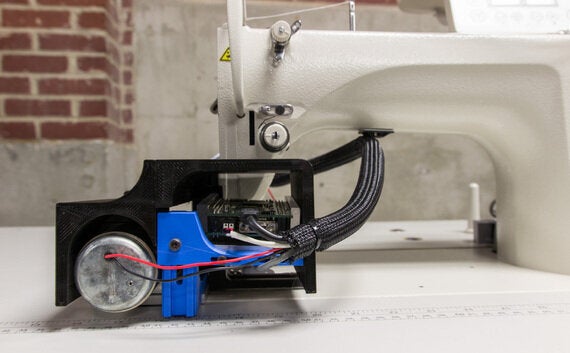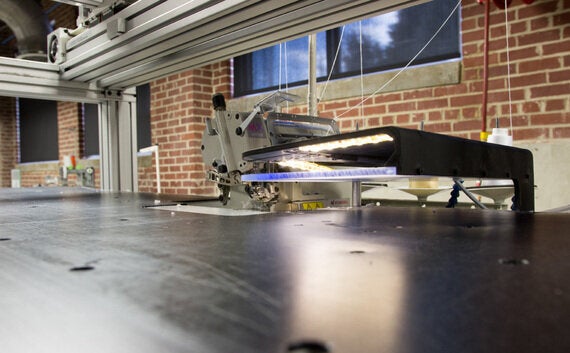It would seem that robots are about to render 'Made in' labels meaningless and could reverse the globalisation of garment manufacturing.
A skilled seamstress is not easy to find. They're even harder to replace. Most young people seem to prefer the more romantic idea of fashion designing as a career.
And given most machinists are in their 40s and 50s it looks as though we're going to be facing a skills shortage, at least in developed markets.
The answer could be machines.

SoftWear Automation in Atlanta may have managed to overcome the main technical challenge of garment manufacturing, i.e. feeding through separate pieces of fabric accurately and smoothly to create one coherent result.
Its machines use high-speed photography which captures up to 1,000 frames per second. These images are then interpreted by software to execute the correct the stitch at the correct tension.
To work in conjunction with machine stitching, SoftWear Automation has also produced a materials handling system (LOWRY) which uses a vacuum to pick up and transport fabrics from one process to another.
SoftWear Automation tells us that its machines will be capable of full garment assembly within the next six months. Heavier woven fabrics such as denim already work well. The company is now testing finer fabrics.

As we've seen technology improvements can happen at a rapid pace - from Smartphones to 3D printing to surgical robotics to virtual reality to bio-security to mobile payments to drones.
If so, the garment making industry could be transformed - and the shift may only be 5-10 years away.
Would the world's 60-75m global garment workers be supplanted? Possibly - this would, no doubt, be determined by the relative economics as the technology progresses.
While automation would likely ensure the end of garment worker exploitation the major social and political implications of displacing so many people by machines would need to be considered.
This would be most relevant for countries that rely heavily on garment manufacturing, such as Bangladesh where garment exports account for over 80% of the country's total exports.
If robotic sewing machines were adopted across the board, and to the extent that garment quality output became uniform, would 'Made in' labels be rendered meaningless? Most probably. The only differentiator would be the quality of the materials and trims.
And if production were to become standardised and automated this would also lead to better pricing transparency for the customer.
Would globalisation of the garment manufacturing industry be reversed? This could happen especially given production cycles are becoming shorter as consumers demand new product more frequently. Time to market would be reduced if product could be manufactured closer to the customer.
The entire industry could move to a localised fast fashion model - fast fashion in the true meaning of the term, i.e. swift delivery to market which is the direction it is heading in in any event.
We interviewed SoftWear Automation's CEO, KP Reddy.
1.What kind of garments can your machines produce?
Right now we are perfecting the operations that go into producing everything from a pair of jeans and a t-shirt to prom dresses and suits. Our technology is advancing very quickly. Today we are able to sew basic patterns. The ASM (automated sewing machine) will allow us to sew these pieces together to form a finished garment. As the technology progresses, there is no limit to the possibilities. This technology manufactures garments with a precision beyond that of human hands.
2.How do you see the technology producing in terms of producing more complex garments?
Since our technology is constantly evolving while sewing operations stay the same, we won't have any issue tackling the more complex garments. We have found that rather than hindering the creativity of designers, as you often see with the current apparel manufacturing model, we actually give them more freedom to push the boundaries of design and thereby create more complex pieces with greater accuracy.
3.What kind of fabrics can your machines work with?
There are no limits to the types of fabrics we can work with. Currently we have had a lot of success with denim, heavier pile fabrics, and medium - lightweight cottons. We are already in the process of testing knits and lighter weight fabrics you would see in womenswear. Our computer vision technology identifies different fabrics and makes decisions at the thread level thereby giving us greater flexibility to work with multiple fabric types on the same machine.
4.Can the machines work with silk and/or other delicate fabrics?
Yes. Traditionally these fabrics present issues for even a skilled seamstress and take years of sewing to master. Using our computer vision system, and accounting for friction in fabric handling, we are able to solve those very same issues in a few hours with no learning needed for the machine.
5.I understand your LOWRY system allows for moving fabrics to and from the sewing machines, do you have machines that can automate the application of fusing?
Yes. Our LOWRY systems work in conjunction with your existing machines, whether it's a single needle lockstitch, overlock machine or fuser. They aren't replacing the machine, but rather acting as the operator.
6.Do you have machines that can apply zips, buttons shoulder pads, etc?
Unlike the current automation systems in apparel, we don't limit ourselves to one operation. We are focused on solving for sewn goods construction as a whole, taking into account the various operations that go into that. Our machinery can do an outer seam on a pair of jeans but that same machine can sew an outer seam on a shirt or a collar onto a blouse. It's about knowing how goods are produced and delivering a solution that meets a customer's need from cut piece to finished garment.
7.Do you have machines that can robotically press garments into the finished product?
Again, most of our systems integrate with your existing machinery, so if you are pressing things manually, I'm sure there is a way to automate it.
Rose & Willard makes all its pieces in-house. We are fortunate enough to have highly skilled seamstresses who have many years of experience. We'll be watching the progress of these machines with interest though...
